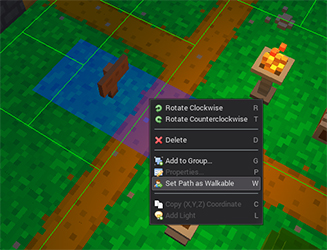RPG in a Box is a tool for easily creating 3D grid-based, voxel-style RPGs and adventure games—everything you will need for building and sharing your own game, all packaged together in a box, so to speak! This "box" will contain an assortment of editors (centered around a map editor and a voxel editor) that will allow you to make your game the way you want. I will be striving to make the software user-friendly so that no knowledge of programming, computer graphics, or modelling will be required, all while still maintaining as many customizable aspects as possible so that your game can be unique.
| Posts | ||
|---|---|---|
| Requested Object Functionality | Locked | |
| Thread Options | ||
| Feb 20 2016 Anchor | ||
|
Here are my suggestions for object functionality:
If I have more thoughts on this topic, I'll add to the list. |
||
| Feb 20 2016 Anchor | ||
|
Thanks VoxelSteve, these are some great suggestions!
The Generic/Group/Specific features are somewhat in progress at this point. Currently, you can select multiple objects with the control key and select Add to Group from the right-click context menu. There's not much you can do with groups right now, but you'll definitely be able to use them in the future for scenarios like you described! The "unique ID" feature is something I am working on for the next release to go along with some of the new scripting functions I will be adding, such as "play_animation". You'll be able to do things like play a specific animation for an object with a unique ID of "Object123, similar to your description.
This is a cool idea and not something I had thought of up until this point. It would definitely open up some interesting possibilities for games. I will add this to my notes!
I believe the Solid/Not Solid feature is handled by the "walkable" property in the Voxel Editor. This checkbox basically defines a default behavior. For example, certain objects, like boulders as you mentioned, should for the most part always block the player. This "walkable" property is used by the Map Editor when generating the navigable paths for the player. So if a sign object is defined as not walkable, when you place the sign into the map, the editor will update the navigation to prevent the player from entering the tile that the object is on. These navigable paths can be tweaked in the Map Editor at any time. You can turn on the display of the navigation paths (toolbar button with 4 green arrows), then select two adjacent tiles. On the right-click context menu, you then have the option to toggle the walkability between those two tiles. Hopefully my explanation for this one makes sense!
This is a great suggestion, also! If I understand correctly, you are saying, for example, instead of having a book as an item inside of a container, you would have a model of the book laying somewhere and you would interact directly with it (display text, image, etc. as you mentioned)? Thanks again for the feedback, I appreciate it! |
||
Only registered members can share their thoughts. So come on! Join the community today (totally free - or sign in with your social account on the right) and join in the conversation.


